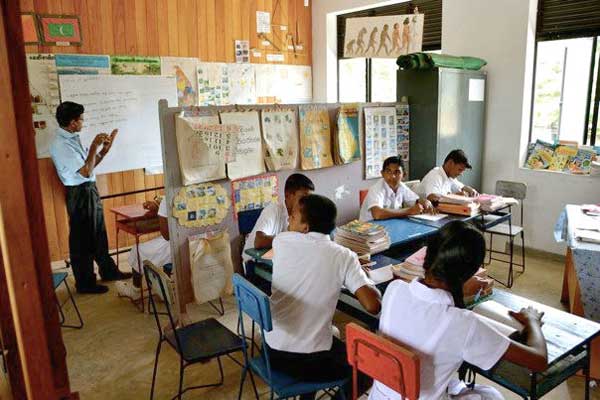Reply To:
Name - Reply Comment
 There has been a sharp fall in government revenue in 2012. Revenue collection is likely to have declined to as low as 11% of GDP. This is significantly less than the 14% - 15% that has been recorded in previous years and compares very unfavourably with 17% - 18% of GDP that is the mean for countries at Sri Lanka’s level of development (lower-middle-income country). It also seems to imply that growth has been less than the 6.5% officially recorded.
There has been a sharp fall in government revenue in 2012. Revenue collection is likely to have declined to as low as 11% of GDP. This is significantly less than the 14% - 15% that has been recorded in previous years and compares very unfavourably with 17% - 18% of GDP that is the mean for countries at Sri Lanka’s level of development (lower-middle-income country). It also seems to imply that growth has been less than the 6.5% officially recorded.
The Pathfinder Foundation (PF), in an Economic Alert issued over six months ago, signaled revenue collection would inevitably fall as the economy slowed down in response to the stabilization measures introduced in Feb/March 2012. Those bold measures were necessary to address the overheating of the economy consequent to the combined effects of adverse global developments and the misaligned interest and exchange rate policies. As anticipated by the PF, the easing of economic activity has resulted in a reduction in VAT collections; the decline in profitability in 2H 2012 has had an impact on corporate taxes; and the depreciation of the currency, tighter monetary policies and tariff adjustments have led to a fall in revenue from import duties (the sharp decline in vehicle imports has been an important causal factor).
Addressing revenue shortfall
Revenue collection of 11% of GDP puts considerable pressure on maintaining: basic services delivery (education, health and welfare); the current size of the public service; debt repayments; and the momentum in infrastructure development. The upshot has been a very sharp cut in public investment and a roll-over of recurrent expenditure to 2013. This is not a sustainable path. The options available to address the revenue shortfall include, inter alia, the following:
1. Increase revenue through tax reforms by continuing the rationalization of the tax code and elimination of exemptions initiated in the Budget Speech (Nov 2010). Also, review the list of zero-rated VAT items. In Sri Lanka, this list is more extensive than in many other countries.
2. Ensure that State Owned Enterprises (SOEs) in key strategic sectors, such as electricity and petroleum, at least break-even instead of imposing a heavy burden on the ordinary people who eventually have to make good their losses through taxes or debt service payments. It is important for a leadership that believes the Government should have a stake in strategic industries to ensure they are not an undue burden on the people. Nevertheless in the final analysis these enterprises need to be restructured through a pragmatic program rather than hanging on to failed ideologies.
3. Meet the twin objectives of containing public investment and maintaining the momentum of infrastructure development by initiating a PPP program.
4. Embark upon a structural reform package that strengthens the growth framework of the economy. It would be dangerous to stimulate growth artificially, at this point, through an over-relaxation of macroeconomic policies. The consequences would be an inevitable over-heating of the import-intensive economy once again, as happened a year ago. However, this time around the consequences would be more serious. The current account of the balance of payments would deteriorate from a position where net foreign reserves are negative and gross reserves are inadequate to meet the external obligations due over the next 12 months. On the other hand, reforms that promote sustained growth would have a positive impact on revenue collection and increase the envelope of resources available to meet expenditures related to education, health, welfare, public service emoluments, debt servicing and essential public investment.
5. Another option is increase borrowing, domestic and foreign. The pressure on resources will be even greater now that budgetary support from the IMF will not be forthcoming. A rise in domestic borrowing will “crowd out” private economic activity through higher interest rates at a time when the economy has already slowed down sharply. Increased foreign commercial borrowing will raise the already elevated risks associated with external debt sustainability. The worst option would be for the Central Bank to print significant amounts of money (i.e. purchase treasury bills and bonds). This has the most deleterious effects on the economy through its impact on inflation and the balance of payments.
These options are not mutually exclusive. In most instances, policy-makers mix and match them. Ultimately, the reforms of the type contained in the first three options will be inevitable. Over- reliance on the last one will place the economy on the path to a major crisis.

Mismatch
It must be acknowledged that these reform options are politically difficult. There tends to be a mismatch between “pain” and “gain”. Though the “pain” associated with reforms will be felt in the short-term (inevitable as the country has been living beyond its means), the “gains” will only emerge in the medium-term. They will eventually significantly outweigh the pain. It must also be recognized that postponing adjustment merely serves to increase the pain when the inevitable reforms are eventually implemented. Countries, like families, cannot live beyond their means indefinitely, particularly if they have lost access to concessional financing through graduation from low-income country status.
In competitive polities, it is the electoral cycle that tends to determine the timing, pace and sequencing of reforms. In this context, it is important to recognize that delaying remedial action for too long can lead to a crisis that would eventually force very drastic austerity measures upon the people of this country. If that comes to pass, it is the poor and vulnerable who feel the brunt of the extreme pain. History has shown that major reforms are usually implemented after a crisis or an election victory.
(This is the Twenty Second Economic Flash published by the Pathfinder Foundation. Readers’ comments are welcome at www.pathfinderfoundation.org. Economic Alert, Economic Flash & Economic Dialogue articles can be viewed at www.pathfinderfoundation.org you can also find us on facebook and follow us on twitter)